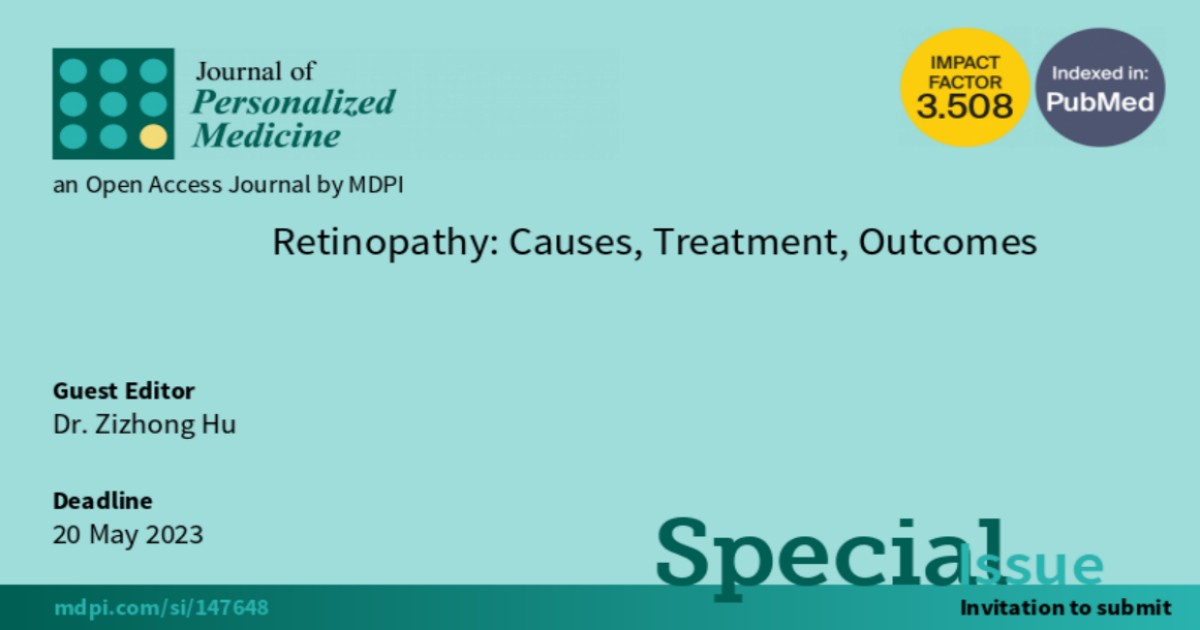Retinopathy: Causes, Treatment, Outcomes
A special issue of Journal of Personalized Medicine (ISSN 2075-4426). This special issue belongs to the section "Mechanisms of Diseases".
Deadline for manuscript submissions: closed (20 May 2023) | Viewed by 9388

Special Issue Editor
Special Issue Information
Dear Colleagues,
The retina is a light-sensing tissue that lines the back of the eye. Retinal diseases, the leading causes of vision loss and blindness, are associated with complicated pathogeneses such as angiogenesis, inflammation, immune regulation, fibrous proliferation, and neurodegeneration. However, questions remain concerning what triggers retinopathy and what obstructs the therapeutical effect of retinal diseases, as well as what changes occur in these individual cells and how they interplay with each other in diseased retinal microenvironment. Recently, the development of new biological techniques, such as single-cell and exosomal sequencing has shed light on explicating pathogenesis of the retinopathy.
In the last few decades, great achievements have been made in the pharmacotherapy and surgery of retinal diseases. Anti-VEGF therapy has been an effective choice for ocular neovascularization, yet there are novel agents targeting dual- or multi-factors to come. Scientists have also found promising results regarding novel therapies, such as stem cell therapy, gene therapy, and exosome-based therapeutics for treatment of retinal disease.
In this article collection, we hope to highlight recent advances contributing to our understanding of the cause, treatment, and outcomes of retinal diseases. We will accept both original research and reviews on, but not limited to, the following subjects:
- Screening methods and new imaging techniques to improve early detection of retinopathy;
- New findings of the retinal pathogenesis process, such as angiogenesis, inflammation, immune regulation, fibrous proliferation, and neurodegeneration;
- Imaging or biological biomarkers for early detection or outcome prediction of retinopathy;
- Pharmacotherapy, surgery, or stem-cell and gene therapy for retinal diseases.
Dr. Zizhong Hu
Guest Editor
Manuscript Submission Information
Manuscripts should be submitted online at www.mdpi.com by registering and logging in to this website. Once you are registered, click here to go to the submission form. Manuscripts can be submitted until the deadline. All submissions that pass pre-check are peer-reviewed. Accepted papers will be published continuously in the journal (as soon as accepted) and will be listed together on the special issue website. Research articles, review articles as well as short communications are invited. For planned papers, a title and short abstract (about 100 words) can be sent to the Editorial Office for announcement on this website.
Submitted manuscripts should not have been published previously, nor be under consideration for publication elsewhere (except conference proceedings papers). All manuscripts are thoroughly refereed through a single-blind peer-review process. A guide for authors and other relevant information for submission of manuscripts is available on the Instructions for Authors page. Journal of Personalized Medicine is an international peer-reviewed open access monthly journal published by MDPI.
Please visit the Instructions for Authors page before submitting a manuscript. The Article Processing Charge (APC) for publication in this open access journal is 2600 CHF (Swiss Francs). Submitted papers should be well formatted and use good English. Authors may use MDPI's English editing service prior to publication or during author revisions.
Keywords
- retinopathy
- pathogenesis
- treatment
- biomarker
- diabetic retinopathy
- age-related macular degeneration
Benefits of Publishing in a Special Issue
- Ease of navigation: Grouping papers by topic helps scholars navigate broad scope journals more efficiently.
- Greater discoverability: Special Issues support the reach and impact of scientific research. Articles in Special Issues are more discoverable and cited more frequently.
- Expansion of research network: Special Issues facilitate connections among authors, fostering scientific collaborations.
- External promotion: Articles in Special Issues are often promoted through the journal's social media, increasing their visibility.
- Reprint: MDPI Books provides the opportunity to republish successful Special Issues in book format, both online and in print.
Further information on MDPI's Special Issue policies can be found here.





